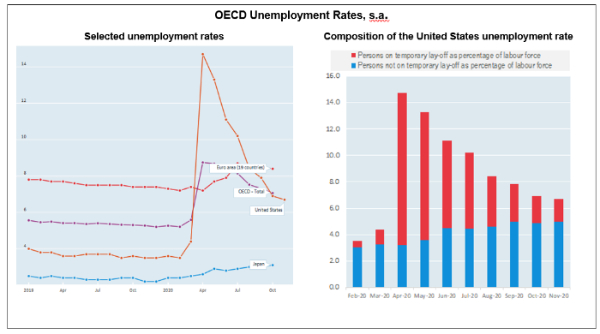OECD Unemployment Rate Falls To 7.1% In October 2020
The OECD area unemployment rate continued to decline in October 2020, to 7.1%, from 7.3% in September, but remained about 2.0 percentage points above the level observed in February, before the COVID-19 pandemic hit the labour market.
The unemployment rate decreased slightly faster among women (down to 7.2% in October, from 7.5% in September) than among men (down to 6.9%, from 7.1%) in OECD countries, narrowing the gap to 0.3 percentage point, from 0.9 percentage point in April. The OECD area unemployment rate for youth (people aged 15 to 24) fell to 14.4% (from 14.7% in September and well below its peak of 19.0% in April 2020).
Some care is needed in interpreting recent falls in the OECD unemployment rate, as this largely reflects the return of temporary laid-off workers in the United States and Canada, where they are recorded as unemployed[1], whereas temporary lay-offs are typically recorded as employed in most other countries.
In the euro area, the unemployment rate decreased marginally to 8.4% in October (remaining 1.2 percentage points above its February level), with decreases of 0.2 percentage point or more in France (to 8.6%), Latvia (to 8.0%), Luxembourg (to 6.5%) and Portugal (to 7.5%). By contrast, the unemployment rate increased by 0.2 percentage point in the Slovak Republic (to 7.0) and Slovenia (to 4.9%).
Outside Europe, the unemployment rate decreased by 1.0 percentage point in the United States (to 6.9%), reflecting the decline in the number of people on temporary lay-off. The unemployment rate decreased by 0.3 percentage point in Colombia (to 16.3), showed little changes in Canada (at 8.9%), Japan (at 3.1%) and Mexico (at 4.6%), but increased by 0.3 percentage point in Korea (to 4.2%). More recent data for November show that the unemployment rate declined further in the United States (to 6.7) and Canada (to 8.5%).
See the full release.
See the tables and charts in Excel.

Visit the interactive OECD Data Portal to explore these data further. Source: OECD calculations based on US Current Population Survey


 ITUC: Workers Must Not Pay The Price Of An Imposed Trade War
ITUC: Workers Must Not Pay The Price Of An Imposed Trade War Greenpeace: Major Deep Sea Mining Company Goes Bankrupt
Greenpeace: Major Deep Sea Mining Company Goes Bankrupt New Zealand Defence Force: Indian And New Zealand Navies Involved In $181m Drug Bust In Indian Ocean
New Zealand Defence Force: Indian And New Zealand Navies Involved In $181m Drug Bust In Indian Ocean Google Cloud Security: North Korea’s Expanding IT Threat - NZ And Other Nations In The Crosshairs
Google Cloud Security: North Korea’s Expanding IT Threat - NZ And Other Nations In The Crosshairs ICHRP: ICHRP Condemns Harassment And Threats Against Victims Of Duterte’s War On The Poor
ICHRP: ICHRP Condemns Harassment And Threats Against Victims Of Duterte’s War On The Poor World Vision: 3.5 Million Displaced Following Myanmar Earthquake And Ongoing Internal Conflict
World Vision: 3.5 Million Displaced Following Myanmar Earthquake And Ongoing Internal Conflict